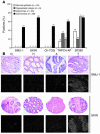A cancer-specific transcriptional signature in human neoplasia
- PMID: 16224537
- PMCID: PMC1253624
- DOI: 10.1172/JCI24862
A cancer-specific transcriptional signature in human neoplasia
Abstract
The molecular anatomy of cancer cells is being explored through unbiased approaches aimed at the identification of cancer-specific transcriptional signatures. An alternative biased approach is exploitation of molecular tools capable of inducing cellular transformation. Transcriptional signatures thus identified can be readily validated in real cancers and more easily reverse-engineered into signaling pathways, given preexisting molecular knowledge. We exploited the ability of the adenovirus early region 1 A protein (E1A) oncogene to force the reentry into the cell cycle of terminally differentiated cells in order to identify and characterize genes whose expression is upregulated in this process. A subset of these genes was activated through a retinoblastoma protein/E2 viral promoter required factor-independent (pRb/E2F-independent) mechanism and was overexpressed in a fraction of human cancers. Furthermore, this overexpression correlated with tumor progression in colon cancer, and 2 of these genes predicted unfavorable prognosis in breast cancer. A proof of principle biological validation was performed on one of the genes of the signature, skeletal muscle cell reentry-induced (SKIN) gene, a previously undescribed gene. SKIN was found overexpressed in some primary tumors and tumor cell lines and was amplified in a fraction of colon adenocarcinomas. Furthermore, knockdown of SKIN caused selective growth suppression in overexpressing tumor cell lines but not in tumor lines expressing physiological levels of the transcript. Thus, SKIN is a candidate oncogene in human cancer.
Figures







Similar articles
-
Expression of E1A in terminally differentiated muscle cells reactivates the cell cycle and suppresses tissue-specific genes by separable mechanisms.Mol Cell Biol. 1996 Oct;16(10):5302-12. doi: 10.1128/MCB.16.10.5302. Mol Cell Biol. 1996. PMID: 8816442 Free PMC article.
-
The tumor suppression activity of E1A in HER-2/neu-overexpressing breast cancer.Oncogene. 1997 Feb 6;14(5):561-8. doi: 10.1038/sj.onc.1200861. Oncogene. 1997. PMID: 9053854
-
E2F activates late-G1 events but cannot replace E1A in inducing S phase in terminally differentiated skeletal muscle cells.Oncogene. 1999 Sep 9;18(36):5054-62. doi: 10.1038/sj.onc.1202897. Oncogene. 1999. PMID: 10490842
-
Adenovirus and cell cycle control.Front Biosci. 2002 May 1;7:d1369-95. doi: 10.2741/ben. Front Biosci. 2002. PMID: 11991831 Review.
-
Cancer-specific gene therapy.Adv Genet. 2005;54:235-55. doi: 10.1016/S0065-2660(05)54010-0. Adv Genet. 2005. PMID: 16096014 Review.
Cited by
-
Differentiation-associated microRNAs antagonize the Rb-E2F pathway to restrict proliferation.J Cell Biol. 2012 Oct 1;199(1):77-95. doi: 10.1083/jcb.201206033. J Cell Biol. 2012. PMID: 23027903 Free PMC article.
-
Survival prediction of stage I lung adenocarcinomas by expression of 10 genes.J Clin Invest. 2007 Nov;117(11):3436-44. doi: 10.1172/JCI32007. J Clin Invest. 2007. PMID: 17948124 Free PMC article.
-
An atlas of altered expression of deubiquitinating enzymes in human cancer.PLoS One. 2011 Jan 25;6(1):e15891. doi: 10.1371/journal.pone.0015891. PLoS One. 2011. PMID: 21283576 Free PMC article.
-
DEPDC1B coordinates de-adhesion events and cell-cycle progression at mitosis.Dev Cell. 2014 Nov 24;31(4):420-33. doi: 10.1016/j.devcel.2014.09.009. Epub 2014 Nov 24. Dev Cell. 2014. PMID: 25458010 Free PMC article.
-
Knockdown of DEPDC1B inhibits the development of glioblastoma.Cancer Cell Int. 2020 Jul 15;20:310. doi: 10.1186/s12935-020-01404-7. eCollection 2020. Cancer Cell Int. 2020. PMID: 32684847 Free PMC article.
References
-
- Ramaswamy S, Golub TR. DNA microarrays in clinical oncology. J. Clin. Oncol. 2002;20:1932–1941. - PubMed
-
- Iafrate AJ, et al. Detection of large-scale variation in the human genome. Nat. Genet. 2004;36:949–951. - PubMed
-
- Jones C, et al. Molecular cytogenetic identification of subgroups of grade III invasive ductal breast carcinomas with different clinical outcomes. Clin. Cancer Res. 2004;10:5988–5997. - PubMed
Publication types
MeSH terms
Substances
Grants and funding
LinkOut - more resources
Full Text Sources
Other Literature Sources
Molecular Biology Databases

